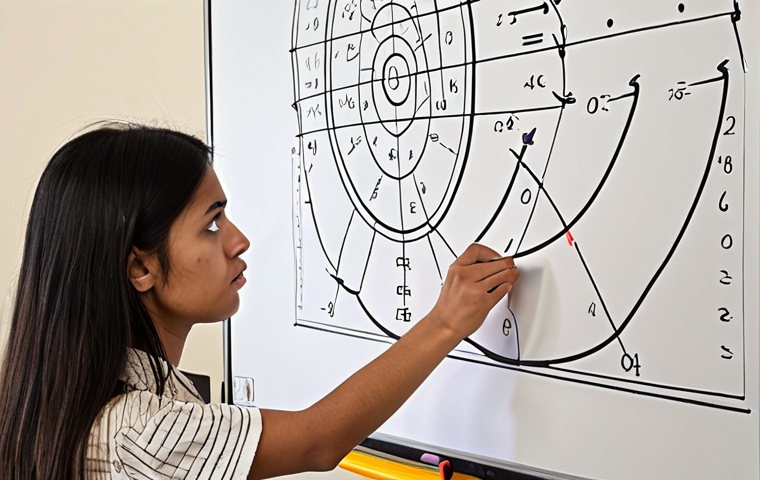Staring at a complex physics problem can feel like hitting a brick wall, right? I distinctly remember those late nights, feeling utterly overwhelmed by equations and concepts that just wouldn’t click.
It’s genuinely frustrating when you’ve memorized formulas but can’t apply them to novel scenarios. In today’s fast-paced world, where information is abundant, truly mastering the *art* of problem-solving, especially in physics, is more crucial than ever.
It’s not just about what you know, but how you *think*. Let’s get into the specifics.
Staring at a complex physics problem can feel like hitting a brick wall, right? I distinctly remember those late nights, feeling utterly overwhelmed by equations and concepts that just wouldn’t click.
It’s genuinely frustrating when you’ve memorized formulas but can’t apply them to novel scenarios. In today’s fast-paced world, where information is abundant, truly mastering the *art* of problem-solving, especially in physics, is more crucial than ever.
It’s not just about what you know, but how you *think*. Let’s get into the specifics.
Unlocking the Core: Beyond Memorization

When I first delved into physics, I fell into the classic trap of trying to memorize every formula, every derivation, every single rule. I thought if I just knew *enough* facts, the problems would magically solve themselves.
Boy, was I wrong! It was like trying to navigate a dense jungle with just a map of individual trees. What I quickly realized, through countless hours of frustration and breakthrough, was that true mastery isn’t about rote memorization; it’s about understanding the underlying principles, the fundamental concepts that govern the physical world.
For instance, knowing “F=ma” is one thing, but truly grasping *why* and *how* force relates to mass and acceleration in various scenarios, from a gentle push on a shopping cart to a rocket launching into space, is another entirely.
This deep conceptual understanding acts as your compass, guiding you through unfamiliar territory. Without it, you’re just flailing in the dark, hoping to stumble upon the right answer.
I’ve seen so many students, myself included, hit this wall because they tried to skip the conceptual groundwork. It’s tough, it takes time, but it’s absolutely non-negotiable for real progress.
1. Deeper Dive into First Principles
My breakthrough moments always came when I stopped trying to force a formula onto a problem and instead stepped back to consider the fundamental physical laws at play.
What’s actually happening here? Is energy conserved? Is momentum conserved?
Is there a torque involved? These aren’t just academic questions; they’re the bedrock of every physics problem. For example, when tackling a complex mechanics problem involving multiple forces, instead of immediately reaching for Newton’s Second Law, I’ve learned to first sketch a free-body diagram and think about *each* force acting on the system.
What is its source? What is its direction? Is it constant or changing?
This deliberate process of dissecting the situation into its most basic components helps illuminate the path forward, rather than getting lost in a jumble of variables.
It feels almost meditative once you get into the rhythm of it, like peeling back layers to reveal the core truth. It’s about building a robust mental model, not just a collection of disconnected facts.
2. The Power of “Why”: Questioning Assumptions
One of the most transformative habits I developed was constantly asking “why?” Why does this formula apply here? Why does this force act in this direction?
Why is this approximation valid? This relentless questioning, often initially fueled by my own confusion, pushed me beyond surface-level understanding.
I recall a particularly tough problem involving fluid dynamics where I kept getting the wrong answer. It wasn’t until I questioned my assumption about the fluid’s incompressibility that the solution clicked.
Turns out, my textbook had simplified it, but the real-world scenario implied otherwise. This made me realize that even well-established theories have boundaries and specific conditions under which they apply.
Engaging with physics in this interrogative way isn’t just about problem-solving; it’s about cultivating a scientific mindset, developing a critical eye that allows you to identify subtleties and nuances that others might miss.
It’s a habit that serves you well far beyond the classroom, in any field requiring deep analytical thinking.
Deconstructing the Labyrinth: The Art of Breaking Down Problems
There’s something incredibly intimidating about a physics problem that spans half a page, filled with multiple scenarios, variables, and obscure conditions.
I used to stare at them, feeling my brain freeze up, convinced I couldn’t even begin. But over time, I discovered that these “monsters” are almost always just a series of smaller, more manageable puzzles stitched together.
My strategy shifted from trying to swallow the whole elephant at once to figuring out how to cut it into bite-sized pieces. It’s a fundamental approach in engineering and research too: complex systems are best understood by analyzing their components.
This process, often called decomposition, is less about innate genius and more about disciplined, systematic thinking. It’s about creating a roadmap where none seems to exist, transforming a daunting challenge into a series of achievable steps.
1. Identifying the Knowns and Unknowns
Before even touching an equation, I always start by creating a clear inventory. What information am I given? What are the specific values?
What am I trying to find? This sounds ridiculously simple, but it’s a step so many people skip, myself included, in their eagerness to jump straight to calculations.
For example, in a projectile motion problem, I’d list initial velocity, launch angle, and target height under “Knowns,” and then “time of flight” and “maximum range” under “Unknowns.” This simple act of organization brings incredible clarity.
It helps you see what tools (formulas) you have available and what tools you still need to acquire. It’s like preparing your toolkit before starting a repair job; you wouldn’t just grab a random wrench and hope for the best, right?
This systematic approach dramatically reduces the feeling of being overwhelmed because you’re no longer staring at a shapeless blob of information, but a structured list of inputs and desired outputs.
2. Segmenting the Journey: Breaking Down Complex Scenarios
Many physics problems involve multiple stages or transitions. Think about a ball rolling down a ramp, then sliding across a rough floor, and finally compressing a spring.
Each of these phases involves different physical principles and equations. My approach is to treat each phase as a separate mini-problem. I analyze the initial conditions for the first phase, calculate the intermediate results, and then use those results as the initial conditions for the next phase.
This sequential thinking is a game-changer. For instance, in that ball example, I’d first analyze the ramp (conservation of energy/Newton’s laws), then the rough floor (work-energy theorem/kinematics with friction), and finally the spring (conservation of energy/Hooke’s Law).
I even draw little boundary lines on my paper to visually separate these stages. This prevents me from mixing up variables or applying the wrong equations to the wrong part of the journey.
It’s like planning a long road trip by breaking it down into distinct legs with clear waypoints.
Visualizing the Invisible: Diagrams, Analogies, and Mental Models
Physics deals with concepts that are often abstract and invisible to the naked eye – forces, fields, energy transformations. I can’t tell you how many times I’ve felt utterly lost trying to grasp something like magnetic fields or quantum probabilities purely from equations.
My brain just rebelled! It was only when I started actively trying to visualize these concepts, either through drawing diagrams or finding relatable analogies, that they began to make sense.
This isn’t just a learning hack; it’s how many top physicists and engineers think. They don’t just crunch numbers; they “see” the physics happening. This visual and intuitive understanding transforms an intimidating set of symbols into a dynamic, tangible process.
It’s like trying to understand a complex dance routine by just reading the choreographer’s notes versus watching it being performed.
1. The Indispensable Role of Diagrams and Free-Body Diagrams
If there’s one piece of advice I could give anyone struggling with physics, it’s this: *draw a diagram*. Every single time. Whether it’s a simple sketch of a block on an incline, a more complex circuit diagram, or a detailed free-body diagram showing all forces acting on an object, these visual aids are invaluable.
I remember once spending an hour trying to solve a torque problem mentally, and getting nowhere. The moment I drew the object, marked the pivot point, and sketched out all the forces and their lever arms, the solution practically jumped off the page.
Free-body diagrams, in particular, force you to identify every relevant force, its direction, and its point of application, which is crucial for applying Newton’s laws correctly.
They translate the abstract into the concrete, revealing hidden relationships and often highlighting symmetries or omissions you might have otherwise missed.
It’s a small investment of time that pays dividends in accuracy and understanding.
2. Leveraging Analogies and Thought Experiments
Sometimes, a concept is so abstract that even a diagram isn’t enough. That’s when I turn to analogies. For example, understanding electric potential difference (voltage) became much clearer when I started thinking of it like gravitational potential energy – a height difference that “wants” to push something down.
Similarly, current flow made more sense when I pictured water flowing through pipes. While analogies are never perfect, they provide a much-needed bridge from the unfamiliar to the familiar, helping your brain latch onto a new concept.
Similarly, thought experiments, like Einstein’s train and light beam, allow you to explore the implications of a physical law in a hypothetical scenario.
I’ve often used them to test my own understanding: “If this were true, what would happen if…?” This kind of imaginative play solidifies your grasp of the physics and helps you intuitively predict outcomes, rather than just crunching numbers blindly.
Mastering the Toolkit: Becoming Fluent in the Language of Math
Let’s be honest: physics and math are inseparable. Many of my early struggles weren’t just with the physics concepts themselves, but with the mathematical manipulations required to solve the problems.
It felt like I understood the *idea*, but then got tangled in the algebra, trigonometry, or calculus. This is a common bottleneck, and honestly, it can be incredibly demotivating.
I remember a particularly complex problem in electromagnetism that required solving a nasty differential equation, and I just froze. It wasn’t the physics that was hard at that point, it was my rusty math skills holding me back.
What I learned is that just as physics has its principles, mathematics provides the precise language to express and quantify those principles. You don’t need to be a math genius, but you do need to be proficient and confident in applying the right mathematical tools.
This fluency allows you to translate your conceptual understanding into concrete, calculable solutions.
1. Precision in Algebra and Unit Consistency
The sheer number of variables in physics problems means that algebraic manipulation is your daily bread and butter. A single sign error, a misplacement of a term, or a division instead of multiplication can send you spiraling into the wrong answer.
I’ve learned, through painful experience, the value of meticulous, step-by-step algebra. Writing out each step, no matter how trivial it seems, reduces errors significantly.
Furthermore, being obsessive about unit consistency is paramount. I’ve seen countless correct conceptual approaches yield absurd answers because someone mixed centimeters with meters, or grams with kilograms, without proper conversion.
Always include units in your calculations and treat them like algebraic variables – if they don’t cancel out to give you the expected unit for your final answer, you know you’ve made a mistake somewhere.
This simple check is a powerful diagnostic tool that saved me from submitting many wrong answers.
2. Navigating Trigonometry, Vectors, and Calculus
Depending on the level of physics, you’ll constantly encounter trigonometry, vectors, and calculus. My advice here is to not shy away from them but to embrace them as essential parts of your toolkit.
Reviewing your trigonometry identities, understanding vector addition and decomposition, and practicing derivatives and integrals until they become second nature are crucial.
For example, almost every force problem on an incline will involve sine and cosine to resolve forces into components. Projectile motion *is* a vector problem.
And much of advanced physics, from kinematics to electromagnetism, relies heavily on calculus. If you find yourself consistently stumbling over the math, it’s worth dedicating specific time to shore up those mathematical foundations independently.
I used to think of math as a separate subject, but in physics, it’s just a different dialect of the same language. Here’s a quick reference for common mathematical tools and their physics applications:
| Mathematical Tool | Key Skill | Common Physics Application |
|---|---|---|
| Algebra | Rearranging equations, solving for unknowns, substitution. | Solving for velocity, acceleration, force, energy in any context. |
| Trigonometry | Resolving vectors, calculating angles, dealing with inclined planes. | Force components on ramps, projectile motion, wave analysis. |
| Vectors | Addition, subtraction, dot product, cross product, components. | Forces, velocities, accelerations, electric/magnetic fields, momentum. |
| Calculus (Differential) | Rates of change, slopes, instantaneous values. | Velocity from position, acceleration from velocity, force from potential energy. |
| Calculus (Integral) | Accumulation, areas under curves, total change. | Position from velocity, work from force, potential from electric field. |
The Power of Persistence: Learning from Every Stumble
Let’s be real, physics is hard. You will get problems wrong. Many, many problems.
I certainly did. There were moments I felt utterly defeated, staring at a red mark on a homework assignment or a quiz, convinced I just wasn’t “smart enough.” But what I slowly came to understand is that failure isn’t the end; it’s an incredibly powerful data point.
Every incorrect answer, every mistake, is a signpost pointing directly to a gap in your understanding. My biggest leaps in problem-solving ability didn’t come from getting things right initially, but from meticulously dissecting where I went wrong.
It’s about cultivating a mindset where mistakes aren’t something to be feared or hidden, but something to be embraced and learned from. This shift in perspective was, for me, the most significant change in my entire learning journey.
1. Post-Mortem Analysis: Dissecting Your Mistakes
When I got a problem wrong, especially on an exam or a graded assignment, my immediate instinct used to be to just look at the correct answer and move on.
Big mistake! Now, my routine is to perform a detailed “post-mortem.” I’ll revisit the problem, the solution, and my attempt, side-by-side. Where exactly did I diverge?
Was it a conceptual misunderstanding? Did I misinterpret the question? Was it an algebraic error?
A unit conversion slip-up? Did I use the wrong formula, or apply the right formula incorrectly? This analytical process is crucial.
I often write down a short note explaining my mistake and the correct approach. For instance, “Mistake: Forgot to account for friction. Lesson: Always draw FBD and list all forces.” This meta-cognition, thinking about *how* you think and *where* you went wrong, is far more valuable than simply memorizing the correct solution.
It teaches you to identify your own blind spots.
2. The Value of Re-Attempting Problems
After understanding *why* I got a problem wrong, I make it a point to re-attempt it a day or two later without looking at the solution. This is a game-changer.
It’s not about rote memorization of the answer; it’s about seeing if I can *apply* the lessons learned from my mistake to arrive at the correct solution independently.
Sometimes I still get it wrong the second time, which tells me my understanding isn’t solid yet, and I need to go back to the drawing board. This iterative process of trying, failing, analyzing, learning, and re-attempting is the true engine of mastery.
It builds resilience and confidence because you’re actively engaging with your weaknesses and turning them into strengths. It’s a bit like a musician practicing a difficult passage until they can play it flawlessly; you’re rehearsing your problem-solving process until it becomes fluid and accurate.
This commitment to persistence is what separates those who truly master physics from those who merely pass.
Beyond the Solo Act: Collaboration and Community
For a long time, I treated physics as a solitary endeavor. It was just me, the textbook, and the problem set. If I got stuck, I’d wrestle with it alone for hours, sometimes to no avail.
I remember countless nights where I just stared blankly at a page, feeling utterly isolated in my struggle. It was only when I reluctantly started engaging with classmates, going to study groups, and asking questions of my professors that my progress truly accelerated.
Physics, and indeed most scientific discovery, is fundamentally a collaborative enterprise. Sharing ideas, explaining concepts to others, and hearing different perspectives can unlock insights you’d never find on your own.
It’s about leveraging the collective brainpower of a community, rather than relying solely on your individual capacity.
1. The Unparalleled Benefit of Explaining to Others
My most profound moments of understanding often came not when I was solving a problem myself, but when I was trying to explain a concept or a solution to a peer.
There’s a phenomenon known as the “Protégé Effect,” where teaching something to someone else deepens your own understanding. When you have to articulate a concept clearly, simplify complex ideas, and answer questions, you’re forced to confront any gaps in your own knowledge.
I’ve caught countless errors in my own reasoning while trying to walk a friend through a solution. It’s like a built-in quality control system for your understanding.
So, actively seek opportunities to teach or explain. Join a study group and volunteer to present a solution. You’ll be surprised how much you learn about your own thought process in the act of helping others.
It’s a win-win scenario that dramatically boosts retention and clarity.
2. Leveraging Office Hours and Online Forums Wisely
Don’t underestimate the power of your professors’ office hours or well-moderated online forums. I used to be intimidated by office hours, thinking my questions were too “dumb” or that I was bothering the professor.
But I quickly realized they are there precisely to help. A quick 5-minute chat with an expert can often unravel hours of confusion. Come prepared with specific questions, showing that you’ve already put in effort.
Similarly, online physics forums or communities can be fantastic resources, but use them wisely. Don’t just ask for answers; explain your thought process and where you’re getting stuck.
The feedback you receive, often from experienced students or even professionals, can be invaluable for pinpointing misconceptions and learning alternative approaches.
Remember, everyone struggles at some point. Reaching out isn’t a sign of weakness; it’s a sign of a smart, strategic learner who understands that growth often happens at the intersection of individual effort and collective wisdom.
Wrapping Up
After years of grappling with seemingly insurmountable physics problems, what I’ve truly come to appreciate is that mastery isn’t about being a genius; it’s about developing a strategic toolkit and a persistent mindset.
It’s a journey filled with stumbles, breakthroughs, and a whole lot of “aha!” moments. Remember, every concept you grasp, every problem you solve, builds not just knowledge, but a powerful way of thinking that extends far beyond the realm of physics.
Embrace the process, be patient with yourself, and never underestimate the power of truly understanding *why*.
Handy Resources & Tips
1. Leverage Online Learning Platforms: Websites like Khan Academy offer fantastic foundational videos and practice problems. For deeper dives, consider Coursera or edX for university-level courses from top institutions, often with structured problem sets and community forums.
2. Utilize Reputable YouTube Channels: Channels such as “Physics with Professor Dave Explains,” “Walter Lewin’s MIT Physics Lectures,” or “3Blue1Brown” (for math intuition) can provide invaluable alternative explanations and visual demonstrations that complement your textbook.
3. Join or Form a Study Group: Seriously, this is a game-changer. Explaining concepts to peers and collaboratively tackling challenging problems will solidify your understanding in ways solo study simply can’t.
4. Practice, Practice, Practice with Solutions: Don’t just do problems; actively seek out detailed solutions (from your textbook’s solution manual or reliable online sources) *after* you’ve given it your best shot. Analyze *how* the solution was derived, not just what the answer is.
5. Use Flashcards for Key Formulas and Concepts: While rote memorization isn’t the goal, having instant recall of fundamental formulas and definitions can free up mental bandwidth for the deeper problem-solving process. Spaced repetition apps like Anki can be incredibly effective here.
Key Takeaways
Mastering physics problem-solving transcends mere memorization. It requires cultivating a deep conceptual understanding of first principles, breaking down complex challenges into manageable segments, and effectively visualizing abstract concepts through diagrams and analogies. Furthermore, a solid command of mathematical tools is indispensable, as is the resilience to learn meticulously from every mistake. Finally, never underestimate the power of collaboration and explaining concepts to others; it often provides the clearest path to true mastery.
Frequently Asked Questions (FAQ) 📖
Q: How do you truly move beyond just rote memorization in physics and actually understand the concepts deeply enough to apply them to novel situations?
A: Oh, this hits home! I remember those late-night cram sessions in college, frantically trying to stuff every formula into my brain before a big exam. It’s like trying to build an IKEA dresser just by looking at the picture on the box, right?
You might know what the finished product looks like, but without understanding how the pieces fit together, you’re utterly lost. For me, the breakthrough came when I started focusing less on the “what” and more on the “why” and “how.” Instead of just memorizing Newton’s Second Law (F=ma), I’d ask myself: “Why is force proportional to acceleration?
What does that actually mean in a real-world scenario, like pushing a shopping cart or a car breaking down?” I’d sketch out rough diagrams, even if they were just messy stick figures, and try to visualize the forces at play.
It’s about building a mental model, not just a fact file. Honestly, sometimes it feels like learning a new language – you start with vocabulary, but you only truly speak it when you can construct sentences and express ideas spontaneously.
And that takes practice, often messy, frustrating practice. But the “aha!” moment when a concept clicks because you genuinely see it working? That’s pure gold.
Q: What’s the single biggest hurdle you’ve observed or personally experienced when people are trying to tackle really tough physics problems?
A: From my own journey and seeing countless others grapple with this, I’d say the absolute biggest hurdle isn’t the math, or even the initial lack of knowledge.
It’s the fear of getting it wrong, combined with a deep reluctance to embrace the process of failure as part of learning. Seriously, how many times have you stared at a problem, felt that knot in your stomach, and just frozen?
You know the feeling – it’s like getting a flat tire on the freeway; you know you need to fix it, but the sheer inconvenience and unknown can be utterly paralyzing.
People often feel immense pressure to get the “right” answer on the first try. But physics, especially complex problems, isn’t about that. It’s about systematically breaking down the unknown, making educated guesses, testing those guesses, and yes, sometimes going down a completely wrong path.
I recall one particularly brutal electromagnetism problem that took me three full pages of scratch work, just to discover I’d misread one tiny word in the prompt.
Was it frustrating? Absolutely! Did I want to throw my notebook across the room?
You bet! But when I finally got it, after backtracking and re-evaluating, the sense of accomplishment was so much sweeter. That willingness to get messy, to fail fast, and to iterate – that’s the superpower.
Q: Given how overwhelming complex physics can feel, what’s a practical, actionable step someone can take today to start improving their problem-solving skills, beyond just doing more practice problems?
A: Okay, so you’ve done the practice problems, but still feel stuck? I get it. It’s like going to the gym and lifting weights, but not seeing the muscles grow because your form is off.
Beyond just grinding through more problems, one super actionable step I swear by is articulating your thought process out loud, even to yourself, as you work through a problem.
No, seriously! It sounds a bit goofy, talking to an empty room, but it’s incredibly effective. Think of it like this: when you’re explaining something to someone else, even a hypothetical ‘someone,’ your brain is forced to organize your thoughts, identify gaps in your understanding, and articulate the logical steps.
“Okay, so first, I need to identify the knowns and unknowns. Then, I see this involves conservation of energy, so I’ll write down that principle. Wait, is friction negligible here?
If not, how does that change things?” This vocalization, or even just writing down your steps as if you’re teaching it, forces you to confront fuzzy areas.
It stops you from just mindlessly plugging numbers into formulas. I started doing this when I was prepping for graduate school exams, and it completely transformed how I approached problems.
It’s like having an internal dialogue, pushing you to truly reason through the physics, not just recall it. It makes you your own best tutor, and trust me, that’s a skill worth investing in.
📚 References
Wikipedia Encyclopedia
구글 검색 결과
구글 검색 결과
구글 검색 결과
구글 검색 결과
구글 검색 결과



